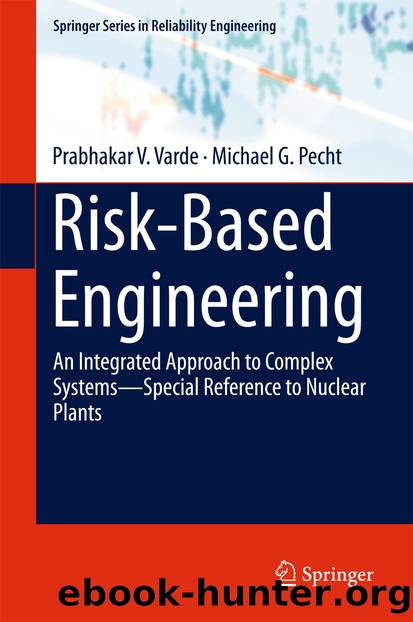Risk-Based Engineering by Prabhakar V. Varde & Michael G. Pecht

Author:Prabhakar V. Varde & Michael G. Pecht
Language: eng
Format: epub
Publisher: Springer Singapore, Singapore
9.2 Treatment of Uncertainty: A Historical Perspective
Most of the cases evaluated as part of safety assessment employ deterministic models and methods. However, if we look at the assumptions, boundary conditions, factors of safety, data, and models of a traditional safety analysis, it can be argued that many of the elements are probabilistic. These elements or variables have qualitative notions for bounding situations and often provide comparative or relative aspects of two or more prepositions. To understand this point further, let us review the traditional safety analysis report(s) and take a fresh look at the broader aspect of this methodology. The major feature of the traditional safety analysis approach is based on the maximum credible accident, and for nuclear plants, these scenarios are mainly loss of coolant accidents (LOCAs) and loss of regulation accidents. It was assumed that the plant design should consider LOCAs and other scenarios, such as station blackout, to demonstrate that the plant is safe enough in terms of regulatory acceptance criteria. However, now the safety community considers a list of postulated initiating events ranging from anticipated, design basis, beyond design basis, and severe accident event conditions.
A reference to a typical safety analysis report or, to be precise, a deterministic analysis report will make it clear that there is an element of probability in a qualitative manner. These insights can include statements such as: (a) the possibility of two-out-of-three train failures is very low, (b) the possibility of a particular scenario involving multiple failures is very unlikely or low, or (c) the series of assumptions that certain conditions are assumed to be not probable or possible, such as failure of three components/systems in series particularly at a single instant. These assumptions or qualitative insights form the boundary conditions for the safety evaluation and show that uncertainty characterization employing qualitative probabilistic aspects is part of the deterministic methods. These aspects are qualitative in nature.
Keeping in view the above, and considerations of factors of safety in the design as part of the deterministic methods, brings out the fact that characterization of uncertainty is integral to safety. Integrated risk-based engineering (IRBE) seeks to (a) be more rational-based and not prescriptive, (b) remove over conservatism, (c) be holistic, (d) allow realistic safety margins, and (e) provide a framework for dynamic aspects of the accident scenario. Therefore, the role of uncertainty evaluation becomes integral to the IRBE approach. Concerning uncertainty characterization, IRBE requires that random phenomena are addressed through aleatory uncertainty and the model and data-related uncertainty are represented as epistemic uncertainty. There are a host of issues in risk analysis where handling of the uncertainty is more important than quantification of uncertainty. The complex issues related to human behavior through the subjective treatment of cognition, consciousness, and conscience are summed up as ethical modeling to provide a holistic approach. These rather qualitative aspects of uncertainty or cognitive uncertainty need to be addressed by having safety provisions in the plant. For application of the integrated risk-based framework, it is vital to address these
Download
This site does not store any files on its server. We only index and link to content provided by other sites. Please contact the content providers to delete copyright contents if any and email us, we'll remove relevant links or contents immediately.
Whiskies Galore by Ian Buxton(40331)
Introduction to Aircraft Design (Cambridge Aerospace Series) by John P. Fielding(32338)
Small Unmanned Fixed-wing Aircraft Design by Andrew J. Keane Andras Sobester James P. Scanlan & András Sóbester & James P. Scanlan(32141)
Craft Beer for the Homebrewer by Michael Agnew(17446)
Turbulence by E. J. Noyes(7039)
The Complete Stick Figure Physics Tutorials by Allen Sarah(6638)
Kaplan MCAT General Chemistry Review by Kaplan(6053)
The Thirst by Nesbo Jo(5785)
Bad Blood by John Carreyrou(5769)
Learning SQL by Alan Beaulieu(5411)
Weapons of Math Destruction by Cathy O'Neil(5036)
Man-made Catastrophes and Risk Information Concealment by Dmitry Chernov & Didier Sornette(4735)
iGen by Jean M. Twenge(4702)
Digital Minimalism by Cal Newport;(4540)
Life 3.0: Being Human in the Age of Artificial Intelligence by Tegmark Max(4507)
Audition by Ryu Murakami(4099)
1,001 ASVAB Practice Questions For Dummies by Powers Rod(4038)
Electronic Devices & Circuits by Jacob Millman & Christos C. Halkias(4027)
Pale Blue Dot by Carl Sagan(4001)
